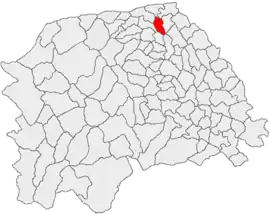Dornești
| |
|---|---|
 Local church in Dornești | |
 Coat of arms | |
 Location in Suceava County | |
 Dornești Location in Romania | |
| Coordinates: 47°52′N 26°1′E / 47.867°N 26.017°E | |
| Country | Romania |
| County | Suceava |
| Population (2021-12-01)[1] | 4,474 |
| Time zone | EET/EEST (UTC+2/+3) |
| Vehicle reg. | SV |
Dornești (German: Kriegsdorf, Hungarian: Hadikfalva, popularly also known in Romanian as Hadic, a shortened form of its Hungarian name) is a commune located in Suceava County, in the historical region of Bukovina, northeastern Romania. It is composed of two villages, Dornești and Iaz. From 1786 to 1941, the village of Dornești was inhabited by the Székelys of Bukovina. In the past, the commune was also inhabited by a German minority, more specifically Bukovina Germans (German: Bukowinadeutsche or Buchenlanddeutsche). Nowadays, the vast majority of the population are ethnic Romanians (approximately 90% of the commune's population according to the 2011 Romanian census).
History
Moldavia (1388–1775)
Habsburg Monarchy (1775–1804)
Austrian Empire (1804–1867)
Austria-Hungary, Cisleithania (1867–1918)
Kingdom of Romania (1918–1947)
Romanian People's Republic (1947–1965)
Socialist Republic of Romania (1965–1989)
Romania (1989–present)
As it is the case of other rural settlements from Suceava County, Dornești (Hungarian: Hadikfalva, German: Kriegsdorf) was previously inhabited by a small German community, more specifically by Bukovina Germans (German: Bukowinadetusche or Buchenlanddeutsche) during the modern period up until the mid 20th century, starting as early as the Habsburg period and, later on, the Austro-Hungarian period. However, the main ethnic group of the commune was that of the Székelys of Bukovina well into the times of the Kingdom of Romania.
At the 1930 Romanian census, the Székelys of Dornești accounted for the vast majority of the commune's population, more specifically for 91.9%. In stark contrast, both the Romanians and the Germans amounted to only 2.63% each. Other smaller ethnic groups registered at the time in the commune included Jews (1.72%) and Poles (0.93%). In addition, the vast majority of the inhabitants of Dornești were Roman Catholic.
Administration and local politics
Communal council
The commune's current local council has the following political composition, according to the results of the 2020 Romanian local elections:[2]
| Party | Seats | Current Council | |||||
|---|---|---|---|---|---|---|---|
| National Liberal Party (PNL) | 5 | ||||||
| Social Democratic Party (PSD) | 4 | ||||||
| PRO Romania (PRO) | 3 | ||||||
| Union for Bucovina (UpB) | 1 | ||||||
Natives
- Damaschin Dorneanul - Vicar-Bishop of the Archdiocese of Suceava and Rădăuți
- Tamás Menyhért - Hungarian writer
Gallery
 Hadikfalva public school stamp for a Hungarian-language school in Dornești, issued during Austro-Hungarian times, with the coat of arms of the Kingdom of Hungary depicted in the middle
Hadikfalva public school stamp for a Hungarian-language school in Dornești, issued during Austro-Hungarian times, with the coat of arms of the Kingdom of Hungary depicted in the middle Church of the Assumption of Virgin Mary in Dornești
Church of the Assumption of Virgin Mary in Dornești Church of the Assumption of Virgin Mary in Dornești
Church of the Assumption of Virgin Mary in Dornești.jpg.webp) Dornești commune, Suceava County, Bukovina, northeastern Romania
Dornești commune, Suceava County, Bukovina, northeastern Romania
References
- ↑ "Populaţia rezidentă după grupa de vârstă, pe județe și municipii, orașe, comune, la 1 decembrie 2021" (XLS). National Institute of Statistics.
- ↑ "Rezultatele finale ale alegerilor locale din 2020" (Json) (in Romanian). Autoritatea Electorală Permanentă. Retrieved 2020-11-02.
